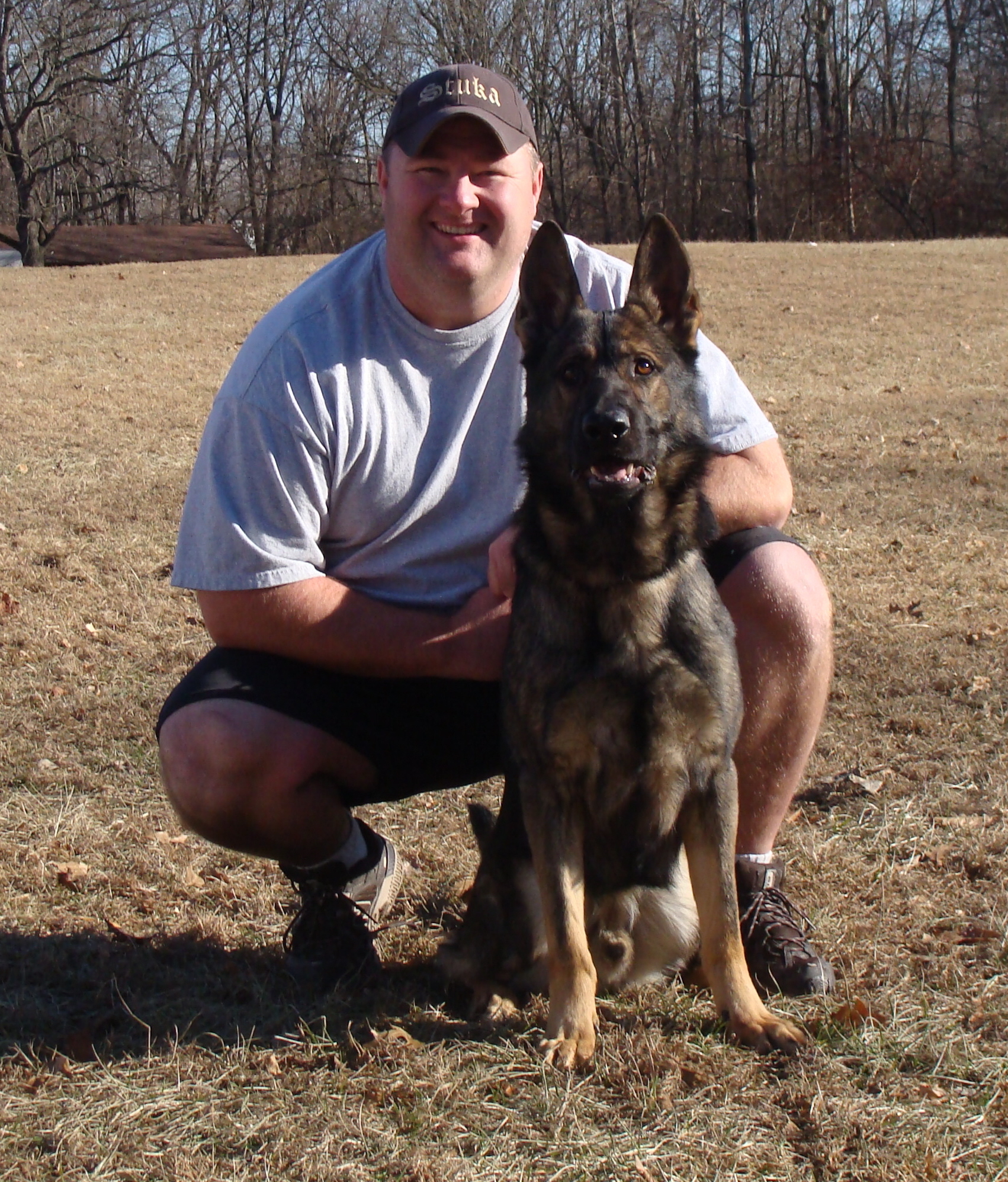Table Training
Table Training;
Theory and Practical Application
written by Nate Harves
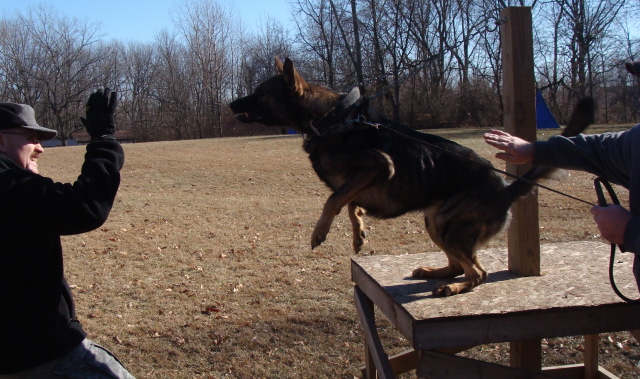
I was reading online the other day and came across some people discussing table training on a dog forum. As usual, there were some people who had some very negative opinions of it and were happy to express them declaring the alleged ignorance of anyone using a table in dog training. I should start by saying, I despise most internet dog training forums as they relate to actual dog training. Why you ask? The reason is very simple. 99% of the people offering advice online have no right to do so because most simply do not know what they are doing. While some people are out busy training, they are busy typing. The internet unfortunately gives a voice to people that would walk onto any respected schutzhund or dog training venue and get checked if they came out with some of the misinformed nonsense they pass on to others. The person that wouldn’t say anything to a respected trainer or breeder will quietly go home as a “computer dog trainer” under an alias, grow ten feet tall, and profess their gospel to all who will listen. Unfortunately, most of the people listening are novice and don’t know any better. That’s where the real damage is done. It makes it very hard for a novice person trying to learn to sort the good information from the bad.
There are many people that do not like table training. And that’s okay. I don’t need everyone to like it just because I utilize it as a tool in my training bag as both a handler and a training helper. There is a lot of misinformation out there on table training and my reason for this article is to offer valid information, encouraging people to research it for themselves and form their own opinions. Table training has been around and evolved so to speak over many years. Done right, a dog can really benefit from it, in my opinion. Done wrong by someone who doesn’t know what they’re doing, it can be very harmful developmentally to your dog as is any other form of training performed incorrectly!
Some older versions of the table meant to put a dog into a fight or flight type drive state by its very design. The table had a post directly in the center of it with a leather collar bolted directly to the post. The dog was loaded up onto the table, its head fastened into the collar securely, and the work began. The theory was that the dog had no option whatsoever of actual flight, so the belief was that the dog would go into showing lots of civil and aggression (meaning showing teeth and intense growling, etc.) What’s important to note here, is that some dogs did just that; but others fell apart. A very strong dog can take a lot of pressure. But most dogs are not this type of dog, and trying to make them something they weren’t in such an unfair and stressful manner could really show holes in the dog, and in my opinion amount to abuse.
This is not how I prefer to work in fight drive. I prefer to develop my dog’s fight drive through success and building confidence, teaching the dog that the helper is a real threat but can be beaten. I don’t even consider the above mentioned table exercise fight drive. Fight drive really says that the animal wants to move forward taking the fight to the bad guy, determined to stay in the fight and defeat the challenger no matter what. To me, this setup is purely defensive in nature. The dog has no options to flee and is doing what he feels he must to survive. That’s where some dogs would show stronger and some would flat submit.
The original theory that the dog could not show flight was incorrect. The ability to physically flee is not required to show flight behavior. Just because the dog cannot physically flee doesn’t mean you haven’t pushed him into a state of flight and the strong desire to do just that at the first real opportunity. If your dog has something to develop, then develop it, just like any other drive or behavior in your dog. But don’t expect him to develop something he simply does not have. True fight drive is not a trained behavior. It must be genetically programmed on some level and then promoted and built through success and confidence in life experiences. A dog with true fight drive, that’s been promoted and built correctly, believes there is no force out there that can defeat him because nothing ever has.
Let’s look for a moment at the difference in dogs and how varied their abilities and thresholds can be when talking about the use of pressure and stress in training. Something that is done to one type of dog and is absolutely not harmful may easily be overkill to another. Take the e-collar for example. The same level of correction that makes my male Stuka say, “Okay, I guess I’ll pay attention” would make some dogs go running for the dog trailer wanting never to return again. It doesn’t mean that level of correction was wrong for Stuka; it just didn’t match this other dog’s needs and genetic abilities. That is where a good dog trainer has to know the dog in front of him or her and treat the dog accordingly, using what works for that particular animal in that particular situation. Some powerful dogs need more effort to control than others. I try to use only as much compulsion as is absolutely required. There is no room in dog sport for a bully who thinks he looks like a big tough guy for mistreating his dog.
With all that being said, I have never utilized the above mentioned type of table training. Instead, I use the table in a positive way to try and tap into some drives and behaviors I like to see in my type of dog. My preference is to utilize the table so that the dog is developed and promoted to show certain behavior and then rewarded, ultimately finding success and building confidence in doing so.
The dog is placed onto the table, the chain is routed under the flat leather agitation collar and chained back into itself at different lengths depending on what is being worked. The reason for under the collar as opposed to a ring is to lessen chances of equipment failure, always being safety minded. The handler maintains a leash to the fur saver on the dog during the work. My training partner and I work on getting the dog to bark at the man, usually starting from a schutzhund blind or a doorway. Simply put, we work the dog along trying to get the strongest barking and behavior we can, and the dog is rewarded for this behavior by the man running away. This teaches the dog that through strong barking, and being forward in his behavior, he can defeat the man. Now that’s a very simple overall run through of what we do, but it’s the basic idea behind it.
Depending on the dog’s genetic strength, the dog’s age, the dog’s training level, and the goals sought from the work, we vary the training to allow us to tap into the dog as best we can without causing problems. The object is to make the dog feel successful and confident by reward, leaving every session feeling stronger than when he came. And when done correctly, I’ve seen results come very fast. The dogs will drag the handler to the table and jump up on it, tail up, looking excitedly around for the man so they can begin the fight. They will start powerfully barking toward where they believe the man is, as if to order the man out so they can engage him. The table allows us to take a dog out of a little bit of their comfort zone on the ground, restrict their movement only slightly, and use just a smidge of that stress and pressure to tap into the stronger barking, defense, or fight drive sought with less stimuli from the helper than might have been needed on the ground.
To say this technique is for a lazy or unskilled helper is absurd. It is a side benefit of the table that the dog will become more active in their drive over time rather than reactive and require less and less from the helper. I have yet to ever see a dog that we’ve worked on a table ever show anything but success. But then again these were dogs already showing us something and being worked correctly and fairly, rewarded, and built over time. We weren’t looking for some magic trick for a dog that didn’t have any confidence to begin with and we weren’t shortcutting other foundation work in the process, such as development on the ground, back tie, etc.
Most people believe that table work is based on fear. In the case of the antiquated table techniques first mentioned I would agree. For some animals this must have been a terrifying experience. However, the table design we use and the way that we apply it have absolutely nothing to do with fear….it is based upon success. The best way to provide an example of this is to show you in person or in video. We’re going to walk through this here for the benefit of the training article and then show you some videos to see it in action.
The basic setup begins with a table such as the one pictured below:
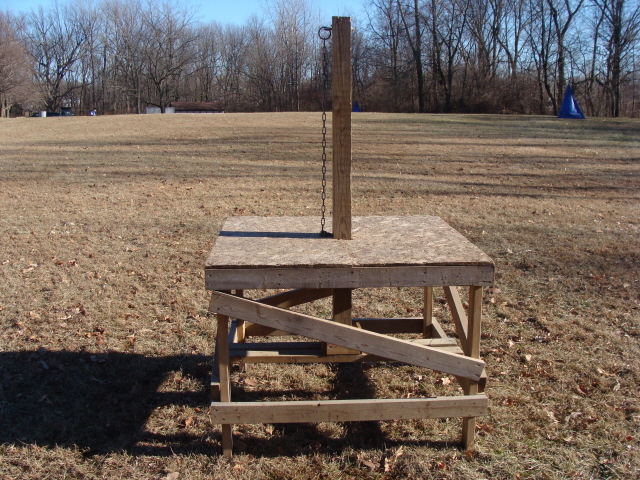
The setup begins with positioning the table a distance of about 25-30 feet from a schutzhund blind or other structure the helper can work out of:
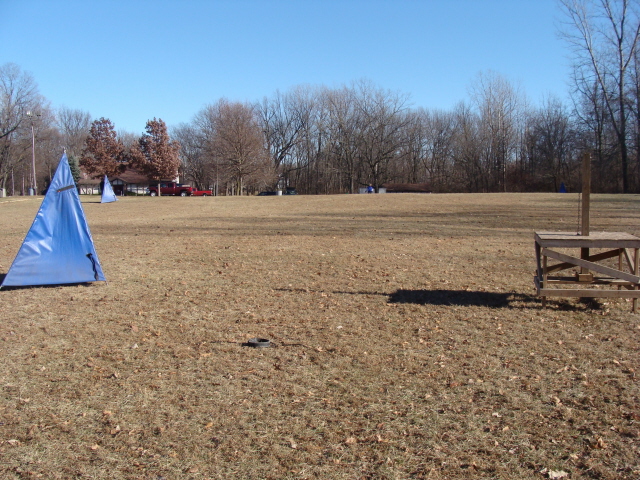
You’ll need a good flat leather agitation collar and a leather lead.
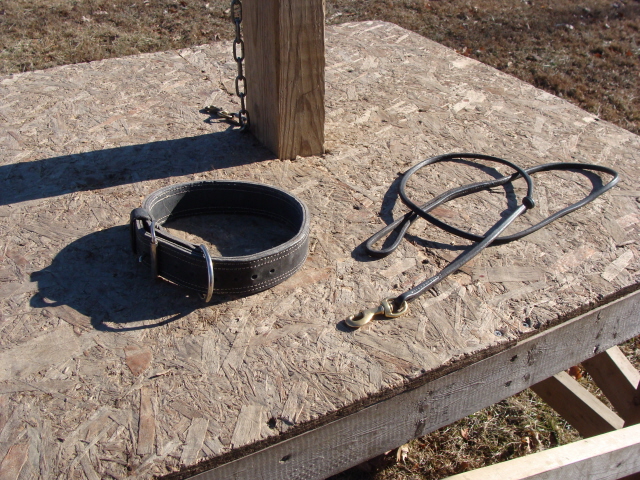
The dog will be loaded onto the table wearing the collar. The chain from the table will then be routed under the collar and secured back into itself as illustrated below:
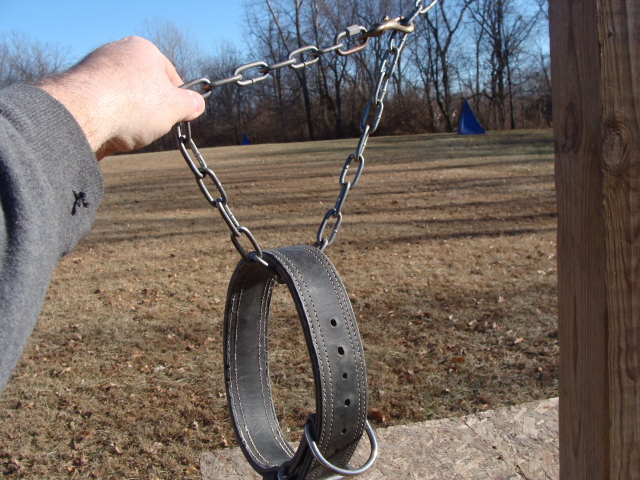
For the dog being introduced to the table, the work begins with the helper distanced from the dog. The helper may just peek out initially or exit the blind a very short distance and begin to work the dog to bark strongly, growl, or show forward behavior toward the helper:
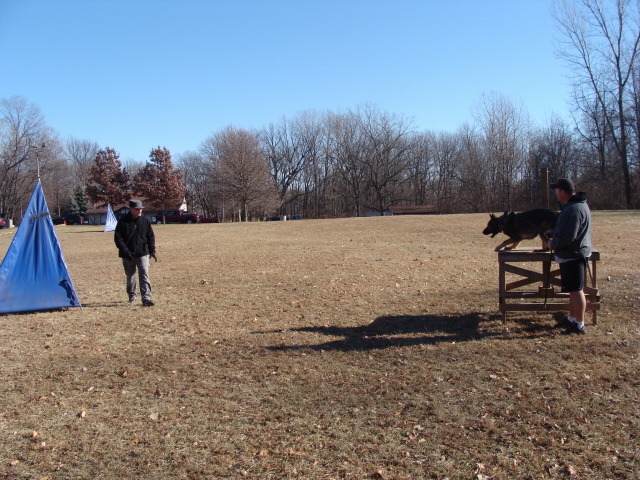
It is very important that when the dog does this, he is rewarded immediately. We reward the dog by running away, applying the practice that in the wild the loser of a confrontation leaves. It is done quickly at first as a beginning stage to build upon and is made very obvious for the benefit of the dog understanding what has happened. As the helper runs away, the handler praises the dog.
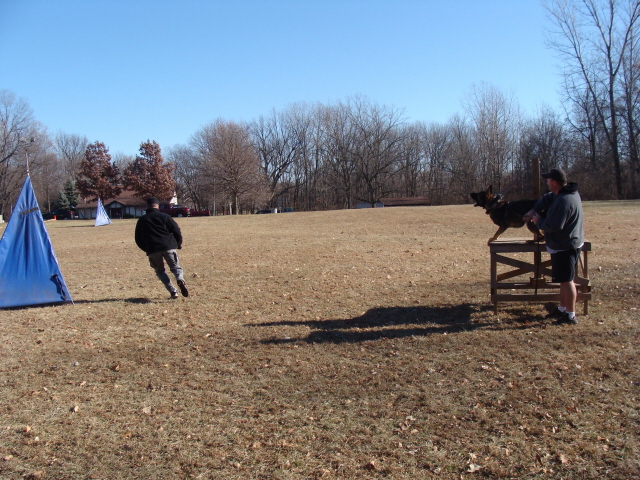
The best way to provide an example of this is to show you. The following is a video that I created with my friend of a dog I had in house for protection training. This male was not a killer nor was he the strongest dog ever born. My effort was to make him more confident and show him that he can find success in strong, powerful barking.
Who there saw a dog scared to death? Who saw abusive trainers mistreating or harming a dog? Was the dog terrified, as if to beg for it to stop so he could find an escape and run for his life? No, of course not. A helper stepped out acting suspiciously, the dog was confused initially, the helper worked the dog, the dog barked, the helper ran away, the dog learned that his barking made the man run away. When the work was done, the dog was unhooked and went to the ground. Did he attempt to flee or did he pull toward the helper?
The handler in this scenario stays beside the dog holding the leather lead attached to the fur saver. There are a few reasons for this. Should the dog mis-step off the table, the handler is right there to recover the dog to good footing. Should there be an equipment malfunction, the second line to the handler provides a backup safety measure for the helper should the dog break free and come at him. Lastly, the dog gets needed support, encouragement, and reassurance from the handler throughout the work at the points where the dog has shown the behavior sought after; forward, confident, strong barking and physical behavior.
The handler is calm and stands almost ignoring the dog. When the helper appears and works the dog to bark, the handler calmly may reinforce the dog quietly, saying “Gooood. Good boy.” It’s important not to say too much or say it so excitedly that the dog becomes more interested in you than the helper. If the dog turns to look at you, stop talking and ignore him. When the dog exhibits behavior that causes the man to run away, pump the dog up and encourage him he’s won. Your voice should be more energized now and really show excitement at what just occurred. “Alright! That’s my BOY!!” Then right back to calm, letting the helper keep the work alive. When the helper really presses the dog, pump the dog up during it to support him and really encourage him as the man runs away. “Watch him! Watch him! Alright! GOOD BOY!!”
Throughout the work, the helper should always be mindful of an invisible line that he does not cross in relation to how close he gets to the dog. One position can bring success, and maybe a foot closer brings defeat. It is important to have the ability as a helper to read the dog and do only what makes the dog more confident. As work goes on, or as the dog develops over time, the helper can press in more and more to tap into more and more. At later stages the helper will close in and begin to slowly reach out toward the dog as if to telegraph to the dog that he’s trying to work through the dog’s display until it becomes so strong that the man concedes defeat and flees. But initially the helper should always maintain a good distance from the dog and always be mindful of how he’s affecting the dog’s confidence.
Here’s an example that shows a helper closely pressing a strong dog and what it may look like. This is 19 month old Stuka son Bello von den Sportwaffen:
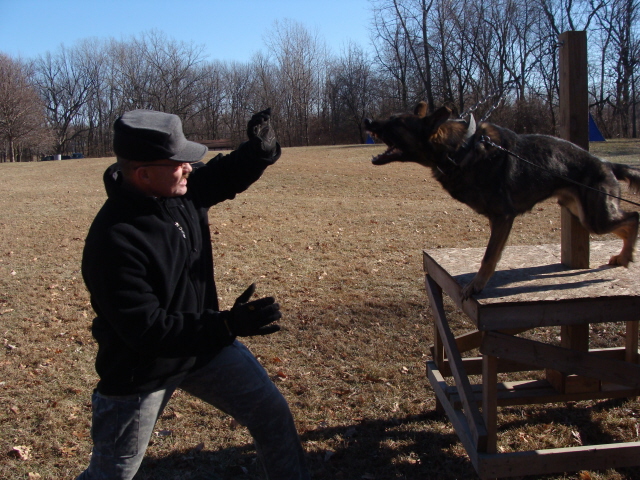
Here’s a video that shows an example of a very strong dog, far along along in his training. Notice the helper comes in much closer and presses the dog significantly more than the earlier video. This work for these dogs is good; but performed on younger or weaker dogs, maybe newer to table training, or without skilled helper work, this same exercise would have negative effects. It is vital that the dog is read correctly and worked within their capabilities. Note that this video shares something with the other video in that after the work is completed, it goes to the ground. This video is of my SG1 Stuka vom Enckhausen SchH3, IPO3, FH, Kkl1, HOT just shy of 3 years of age:
Below is an illustration of the idea of the helper using “boundaries” in the work trying to maximize success out of each session. For instrumental purposes, the handler and the dog appear on the left and the helper is on the right behind the blind. The colored arcs represent:
Green: The position of the helper should start, and end, behind this line and in the blind.
Yellow: The most forward position the helper should press the dog and the position that brings the most positive effect from the dog. (Note: this position changes based upon many factors as discussed.)
Red: This position signifies that the helper has advanced too far and is now defeating the dog rather than producing success. The dog may stop barking here, bark less confidently, or show avoidance to the helper all together. This position (or better stated, the result behavior) must always be avoided!
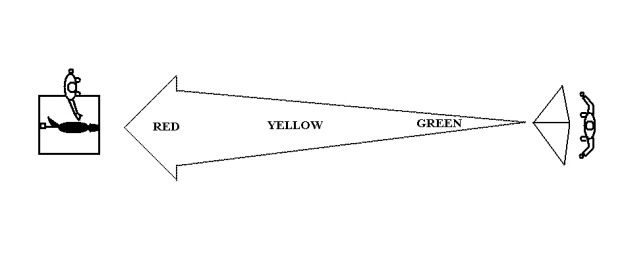
The above illustration gives a rough idea of how the helper gauges himself, but in reality the helper must be able to read dogs and know how far to go. That is key. Done correctly, the table presents options to the trainer in different ways. For one dog I might use it to build confidence. For a dog that handles extreme pressure like my Stuka, I used it to try and tap into some stress to get more civil, aggression, and defense out of an otherwise very confident dog that works mainly in a mixture of very high prey and fight drives. It depends greatly on the dog you have and the result you’re seeking. Over time, through successful development on a strong dog, the red position may disappear all together as the dog achieves total success and confidence toward the man. Nevertheless, the dog always wins and is always rewarded with the man fleeing!
There is much more information, style, and variation that can be discussed on table training but I’ll end it here for the purposes of this article. My goal was to explain what happens in table work when performed correctly, in such a way as to illustrate that it is neither barbaric nor cruel, and that certain dogs can benefit from its use in their development and training. I’m always willing to open my mind and think outside the box for something that can add to my dog’s development and training, and it’s my belief that table training performed properly by experienced handlers and helpers can do just that. I’ve witnessed the improvement in my dogs as a handler, and I’ve viewed it head on as a training helper working other’s dogs.
Complex training topics can be very hard to put into writing sometimes because certain things can be lost in translation or hard to illustrate. I hope you have enjoyed this article and I invite you to share in my passion for the working line German Shepherd Dog!
Nate Harves with 19 month old Stuka son Bello von den Sportwaffen.
Bello is the dog in the photos used for the article.
